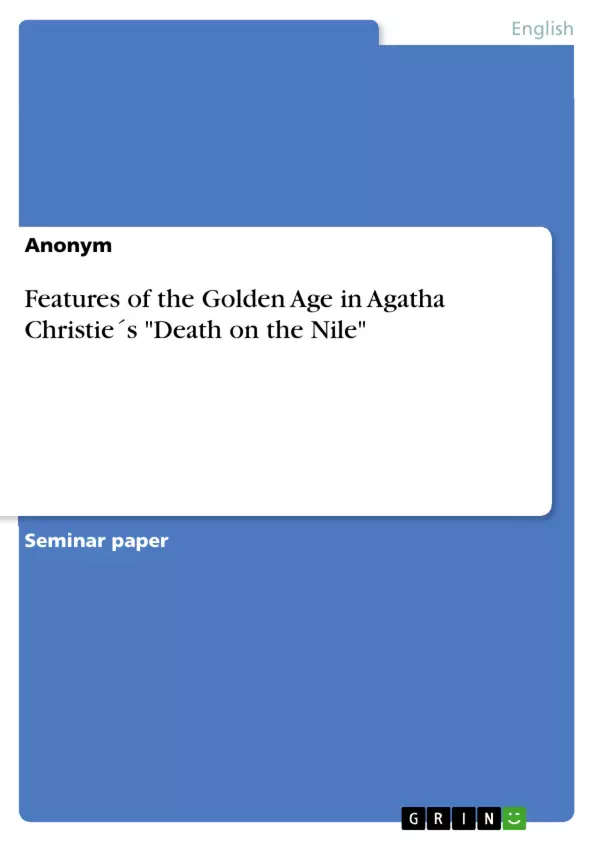The Golden Age is known as the time between the two world wars. During this time, many crime fiction novels were written by several authors. The Mysterious Affair at Styles 1920 by Agatha Christie is often seen as the first novel of the Golden Age crime fiction and In the Teeth of the Evidence 1939 by Dorothy L. Sayers as the last one. The novels often represent social problems, which sounds controversial to the ‘golden’ notion.
The crime fiction novels published in the Golden Age period have many common features which will be discussed in the following pages. The Golden Age features will be compared to Agatha Christie’s novel Death on the Nile (1937). There is a lot of research about crime novels during that period but only a few compare the features of the Golden Age to Death on the Nile, which is why I chose this novel for further analysis. Being a huge fan of crime fiction, I wanted to take a closer look at Agatha Christie’s writing style and see how it fits in the Golden Age period.
One feature she followed is that murder becomes the main feature of the stories published in the Golden Age. By the 1920s words like ‘murder’ or ‘death’ began to be seen in the title (cf. Knight 2010: 86). Especially Agatha Christie’s book titles let the readers know what the book will be about before reading the summary on the cover (e.g. Death on the Nile, Death in the Clouds, Mrs. McGinty's Dead, Murder on the Orient Express), along with authors like Dorothy L. Sayers with Murder Must Advertise, Margery Allingham with Death of a Ghost and Ngaio Marsh with Death on Ecstasy.
These four British authors - Agatha Christie, Dorothy L. Sayers, Margery Allingham, and Ngaio Marsh - were known as “The Big Four” or “The British Quartet”, but only Agatha Christie achieved the honour of being called the “Queen of Crime” (cf. Keitel 2008).
Inhaltsverzeichnis (Table of Contents)
- Introduction
- Agatha Christie and the Detection Club Oath
- Clue-puzzle
- Whodunnit.
- Clues
- Murder weapon
- Enclosed setting
- How the reader is involved
- Detective Hercule Poirot
- Victim
- Conclusion
Zielsetzung und Themenschwerpunkte (Objectives and Key Themes)
The objective of this work is to explore the features of Golden Age crime fiction through a comparative analysis of Agatha Christie's novel Death on the Nile. This will involve examining the shared characteristics of Golden Age crime novels, comparing them to specific elements within Death on the Nile, and analyzing Christie's writing style in relation to the period.
- Characteristics of Golden Age crime fiction
- Agatha Christie's writing style
- The role of murder in Golden Age crime fiction
- The influence of the Detection Club Oath and "fair play" principles
- The portrayal of love and relationships within the context of crime
Zusammenfassung der Kapitel (Chapter Summaries)
- Introduction: This chapter introduces the concept of the Golden Age of crime fiction, outlining its temporal boundaries and highlighting its key characteristics. It also introduces Agatha Christie's Death on the Nile as the focal point for the analysis.
- Agatha Christie and the Detection Club Oath: This chapter explores Agatha Christie's place within the Golden Age crime fiction movement, focusing on her involvement with the Detection Club and her adherence to the "Ten Commandments" and "Twenty rules for writing detective stories." It also discusses the role of love and relationships within Golden Age crime fiction, contrasting the common avoidance of romance with Christie's inclusion of multiple love affairs in Death on the Nile.
- Clue-puzzle: This chapter delves into the concept of "clue-puzzle" within Golden Age crime fiction. It analyzes how the adherence to "fair play" principles, where readers are privy to all the clues presented to the detective, shapes the narrative structure. This chapter also explores the common trope of servants not being the murderers, as seen in Death on the Nile.
Schlüsselwörter (Keywords)
The primary keywords and focus topics of this text include: Golden Age crime fiction, Agatha Christie, Death on the Nile, Detection Club Oath, "fair play" principles, clue-puzzle, murder, love, relationships, writing style, "cosy" novels, and the portrayal of evil.
- Quote paper
- Anonym (Author), 2021, Features of the Golden Age in Agatha Christie´s "Death on the Nile", Munich, GRIN Verlag, https://www.hausarbeiten.de/document/1421444


